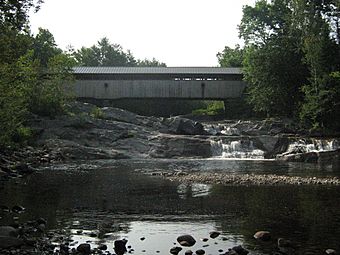Swiftwater Covered Bridge facts for kids
Quick facts for kids |
|
|
Swiftwater Covered Bridge
|
|
 |
|
| Location | Porter Rd., Bath, New Hampshire |
|---|---|
| Area | 0.1 acres (0.040 ha) |
| Built | 1849 |
| Architectural style | Paddleford truss |
| NRHP reference No. | 76000127 |
| Added to NRHP | November 21, 1976 |
The Swiftwater Covered Bridge is a really old and special bridge in Bath, New Hampshire. It's a covered bridge, which means it has a roof and sides, like a tunnel. This bridge carries Porter Road over the Wild Ammonoosuc River. It was built way back in 1849, making it one of the oldest covered bridges still standing in New Hampshire! It's also a great example of a unique building style called the Paddleford truss. Because it's so important, the bridge was added to the National Register of Historic Places in 1976.
Contents
What Makes This Bridge Special?
The Swiftwater Covered Bridge is found in the southeast part of Bath. It helps Porter Road cross the Wild Ammonoosuc River. This bridge is special because of its design. It uses a "Paddleford truss" style. Think of a truss as a strong framework of triangles that helps hold the bridge up.
How the Bridge is Built
The bridge is very long, about 173 feet (53 meters) in total. The part you drive on is about 14 feet (4.4 meters) wide. The roof is made of metal, and the sides have wooden planks. These planks go up about eight feet, leaving an open space above. The openings at each end, called portals, also have these wooden planks.
A Look Back in Time: Bridge History
This bridge is actually the fourth one built in this spot! The first two bridges, built starting in 1810, were washed away by big floods. Imagine how powerful those rivers can be!
Who Built It?
The Swiftwater Covered Bridge was built in 1849. It was probably built by Joseph Fifield and John Carbee. They were town officials in charge of roads and bridges back then.
The Paddleford Design
The special Paddleford truss design was created by Peter Paddleford, who was from New Hampshire. This design was likely chosen because people in the area knew others who worked with Paddleford. It's amazing to think this bridge has survived so many years. People even say it survived when explosives were used nearby to clear logjams in the river!




